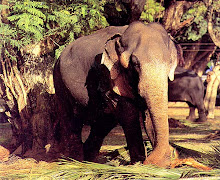 nka. His father, D. A. Rajapaksa, was a prominent politician, independence agitator, Member of Parliament and Cabinet Minister of Agriculture and Land in Wijeyananda Dahanayake's government. D.M. Rajapaksa, his uncle, was a State Counselor for Hambantota in the 1930s who started wearing the earthy brown shawl to represent kurakkan (finger millet) cultivated by the people of his area, whose cause he championed throughout his life. It is from his example that Rajapaksa wears his characteristic shawl.[2]
nka. His father, D. A. Rajapaksa, was a prominent politician, independence agitator, Member of Parliament and Cabinet Minister of Agriculture and Land in Wijeyananda Dahanayake's government. D.M. Rajapaksa, his uncle, was a State Counselor for Hambantota in the 1930s who started wearing the earthy brown shawl to represent kurakkan (finger millet) cultivated by the people of his area, whose cause he championed throughout his life. It is from his example that Rajapaksa wears his characteristic shawl.[2]Rajapaksa was educated at Richmond College, Galle before moving to Nalanda College Colombo and later Thurstan College, Colombo.[2] He also had a few cameo roles as a movie actor in Sinhalese movies and worked as a library assistant at Vidyodaya University.[3]
Following the death of his father in 1967, Rajapaksa took over as the SLFP candidate for Beliatta constituency and was elected to Parliament in 1970 as the youngest Member of Parliament at the age of 24.[3] Later he studied law at the Sri Lanka Law College and took oaths as an attorney-at-law in November 1977.[4] Throughout his parliamentary career, except for the period from 1994-2001 when he was a minister, he continued his law practice in Tangalle.[2]
He lost his parliamentary seat in the landslide defeat of the SLFP in 1977.[2] During the 1985 by-election campaign in the Mulkirigala electorate in Hambantota district, for which his brother Chamal Rajapaksa contested representing the SLFP, during this time Mahinda was remanded for allegations of possession of unauthorized fire arms, but he was cleared of charges due to lack of evidence.
In Opposition
In 1989 he was re-elected to Parliament to represent Hambantota District under Proportional Representation. He came into prominence as a leader, together with Manorani Saravanamuttu, of the Mothers Front, which organised the mothers of the "disappeared" in the white terror of 1988-90 instigated by a rebel group that called themselves Deshapremi Jathika Vyapa
 raya or 'Patriotic National Movement'.[2]
raya or 'Patriotic National Movement'.[2]Political career
Appointment as Cabinet Minister
In 1994, following the election victory of the People's Alliance a political front led by Sri Lanka Freedom Party and headed by Chandrika Kumaratunga, Rajapaksa was appointed Minister of Labour. He held this post until 1997 when, following a cabinet reshuffle, his portfolio was changed to Minister of Fisheries and Aquatic Resources.[2]
Leader of the Opposition
When the United National Party (UNP) defeated the People's Alliance in the 2001 elections, Rajapaksa lost his position in the Government. He was however appointed as Leader of the Opposition in March 2002.[2]
Premiership
Rajapaksa was chosen by the Sri Lanka Freedom Party for the Presidential Election held on November 17, 2005. Rajapaksa prime opponent was former Prime Minister and Opposition Leader, Ranil Wickremasinghe, the leader of the United National Party in this election. Rajapaksa defeated Wickremasinghe narrowly by 190,000 votes and took office as President of Sri Lanka on November 19, 2005. This has often been cited as being a result of the LTTE calling for a boycott of the polls in the North and East from tamil voters in areas within their control. Most voters in these areas were forcibly restrained from voting, and it is common knowledge that they would have favored Ranil Wickremasignhe and his UNP party in the said election..[5] Rajapaksa received 50.3% of the vote.
After becoming President of Sri Lanka, Rajapaksa reshuffled the cabinet and took the portfolios of Defence and Finance in the new cabinet, which was sworn on November 23, 2005.
Mahinda Rajapaksa has become the fifth President of Sri Lanka. The lawyer, human rights activist, former government minister and proud son of Sri Lanka previously served as the Honourable Prime Minister of the 13th Parliament of Sri Lanka. The nation's new President dedicates himself to bringing peace and economic prosperity to all communities in Sri Lanka, ushering in the future while upholding the traditions of the past.


